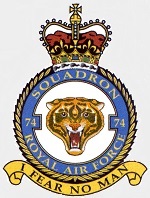Hobby Master HA7813 RAF Supermarine Spitfire Mk. I Fighter - Flt. Lt. Adolph "Sailor" Malan, No.74 Squadron, Hornchurch, England, June 1940 (1:48 Scale)
"Never in the field of human conflict was so much owed by so many to so few."
- British Prime Minister Winston Churchill, commenting on the British airmen in the Battle of Britain
 The Spitfire is the most famous British aircraft of all time. Although less numerous than the Hawker Hurricane, it is remembered as the sleek, thoroughbred fighting machine that turned the tide during the Battle of Britain. The Spitfire was among the fastest and most maneuverable prop-driven fighters of World War II, serving in virtually every combat theater.
The Spitfire is the most famous British aircraft of all time. Although less numerous than the Hawker Hurricane, it is remembered as the sleek, thoroughbred fighting machine that turned the tide during the Battle of Britain. The Spitfire was among the fastest and most maneuverable prop-driven fighters of World War II, serving in virtually every combat theater.
Supermarine designer Reginald Mitchell created this small, graceful, elliptical-wing fighter with eight guns in the wings that were able to fire without being hindered by the propeller. The immortal Spitfire thus became not merely one of the best-performing fighters of all time, but also one of the best-looking. Although never employed as a long-range escort, the Spitfire was a champion in an air-to-air duel. Spitfires routinely dived at the speed of sound, faster than any of the German jets.
A carrier-based version, called the Seafire, was a winner in its own right, serving valiantly on convoy routes during World War II. The Seafire 47 was even used in the early stages of the Korean War, before it was replaced by more modern jet aircraft.
Pictured here is a 1:48 scale replica of a Supermarine Spitfire Mk. I fighter that was piloted by Flt. Lt. Adolph "Sailor" Malan, who was attached to No.74 Squadron, then deployed to Hornchurch, England, during June 1940.
Sold Out!
Dimensions:
Wingspan: 9-inches
Length: 7-1/2-inches
Release Date: February 2018
 Historical Account: "Tiger Squadron" - No. 74 Squadron RAF, also known as "Tiger Squadron" from its tiger head motif, was a squadron of the Royal Air Force. It operated fighter aircraft from 1917 to the 1990s.
Historical Account: "Tiger Squadron" - No. 74 Squadron RAF, also known as "Tiger Squadron" from its tiger head motif, was a squadron of the Royal Air Force. It operated fighter aircraft from 1917 to the 1990s.
On September 6th, 1939, after an early morning air raid alert, a flight of No.56 Squadron Hawker Hurricanes took off from North Weald. These were followed by two reserve Hurricanes. The two reserves were identified as enemy aircraft and Spitfires from Hornchurch, among them No. 74 Squadron, were ordered to attack them. Both were shot down. One pilot, P/O Montague Hulton-Harrop was killed; the other pilot, Frank Rose, survived. The pilot who fired the fatal shots was No.74 Squadron's John Freeborn. The exact story of what happened in this incident, which came to be known as the "Battle of Barking Creek", may never be known. Even the origin of the name is obscure, as it did not take place above Barking Creek but near Ipswich, in Suffolk. This was the first RAF operational death of the war. At the subsequent court martial, it was accepted that the entire incident was an unfortunate error.
The Squadron, as part of No. 12 Group RAF, first saw combat during the evacuation from Dunkirk, in battles which exacted a heavy toll on both pilots and aircraft. Thereafter, No.74 served successfully through the Battle of Britain. Mark I Spitfires were replaced with the Mark IIa in September 1940 at RAF Coltishall. The squadron moved back south to RAF Biggin Hill in October for the end of the Battle. The Squadron went to the north of England in July 1941 to regroup, from there moving around to stations in Wales and Northern Ireland until in April 1942 it was sent, without aircraft, to the Middle East, arriving in Egypt in June. The squadron was then moved to Palestine to operate as a maintenance unit for USAAF B-24 Liberators. It received Hurricane IIbs in December 1942 and served in Iran until May 1943, moving back to Egypt for shipping patrols and conversion to the Spitfire Mk.Vb and Mk.Vc in September 1943. In late October 1943, the squadron got Mk.IX Spitfires, which were swapped for Mk. XVIs in March. No. 74 returned home just in time to take part in the D-Day landings in June 1944, using its aircraft as fighter-bombers supporting the Allied liberation of France, Belgium and the Netherlands.


